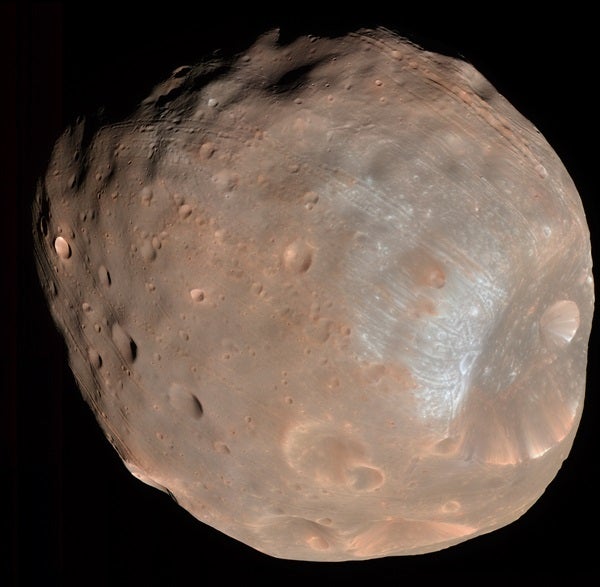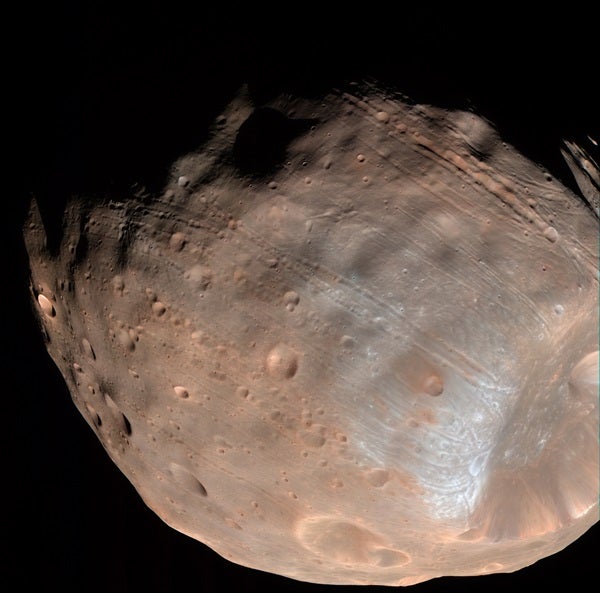The High Resolution Imaging Science Experiment, run from the University of Arizona, has produced a new color stereo view of Phobos, the larger and inner of Mars’ two tiny moons.
The HiRISE camera aboard NASA’s Mars Reconnaissance Orbiter took two images of Phobos 10 minutes apart on March 23. Scientists combined the images for a stereo view.
“Phobos is of great interest because it may be rich in water ice and carbon-rich materials,” professor Alfred McEwen of the UA’s Lunar and Planetary Laboratory, and HiRISE principal investigator, says.
Previous spacecraft, notably Mars Global Surveyor, have taken higher resolution pictures of Phobos because they flew closer to it, HiRISE team member Nathan Bridges of NASA’s Jet Propulsion Laboratory says.
“But the HiRISE images are higher quality, making the new data some of the best ever for Phobos,” Bridges says. “The new images will help constrain the origin and evolution of this moon.”
By combining information from the HiRISE camera’s blue-green, red and near-infrared color channels, scientists confirmed that material around the rim of Phobos’ largest surface feature, Stickney crater, appears bluer than the rest of Phobos. The impact that excavated 9-K, or 5.5-mile, Stickney is thought to have almost shattered the moon.
The HiRISE view also shows landslides along the walls of Stickney and other large craters, Phobos’ striking surface grooves and crater chains, and craters hidden on the moon’s dark side illuminated by Marsshine.
Marsshine is sunlight reflected by Mars onto the moon. The phenomenons analogous to Earthshine, where Earth reflects sunlight that illuminates the dark side of our Moon. Like Earth’s Moon, Mars’ moons Phobos and Deimos are tidally locked on their planet—that is, they always present the same side to the planet they orbit.
The HiRISE images are among several new HiRISE images being released today on the HiRISE web site. The images include an anaglyph, or 3-D view of Phobos that can be viewed with red-blue glasses.
MRO flies at about 7,800 mph between 155 and 196 miles, or between 250 and 316 kilometers, above the surface of Mars.
Phobos was 6,800 kilometers, or about 4,200 miles, away when the HiRISE camera took the first photograph. At that distance, the HiRISE camera was able to resolve surface features at a scale of 6.8 meters, or about 22 feet, per pixel, and see features as small as 20 meters, or 65 feet, across.
Phobos was 5,800 kilometers, or about 3,600 miles, away when the HiRISE camera took the second picture minutes later. At that distance, the HiRISE camera was able to resolve features about 15 meters, or 50 feet, across.
Phobos, only about 13.5 miles, or 22 kilometers, in diameter, has less than one-thousandth the gravity of Earth. That’s not enough gravity to pull the moon into a sphere, so it’s oblong. Mars’ second moon, Deimos, is even smaller, at about 7.5 miles, or 12 kilometers, across. The very dark, diminutive moons may be captured asteroids from the outer, carbon-rich, Mars-Jupiter asteroid belt.











